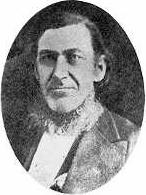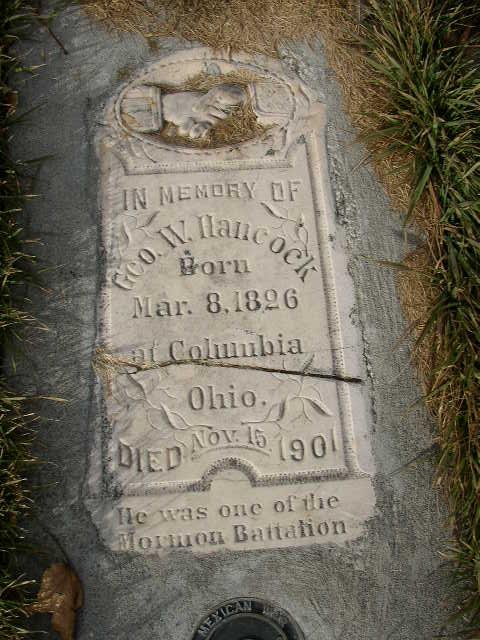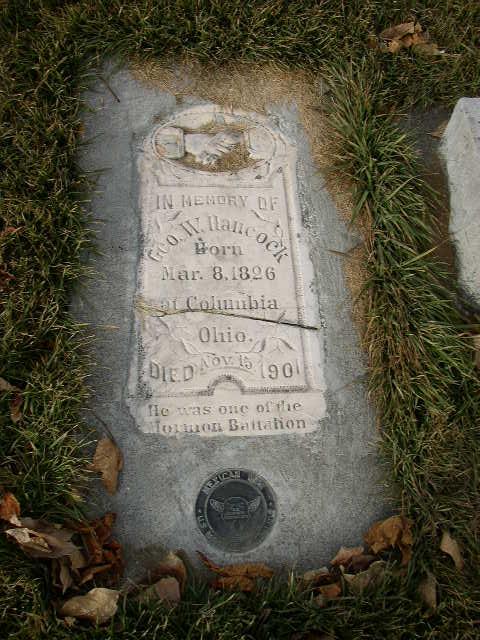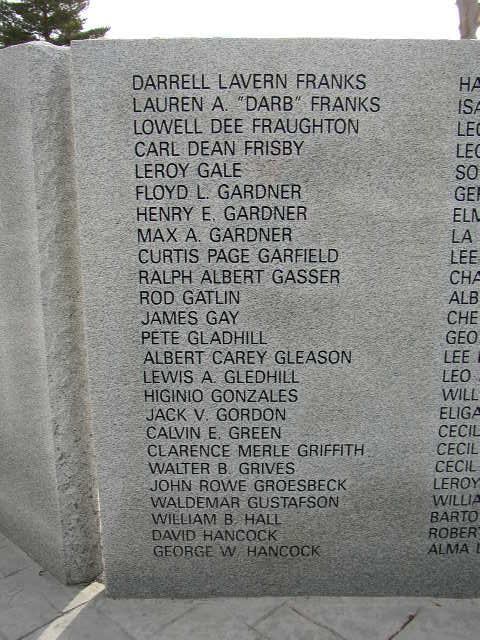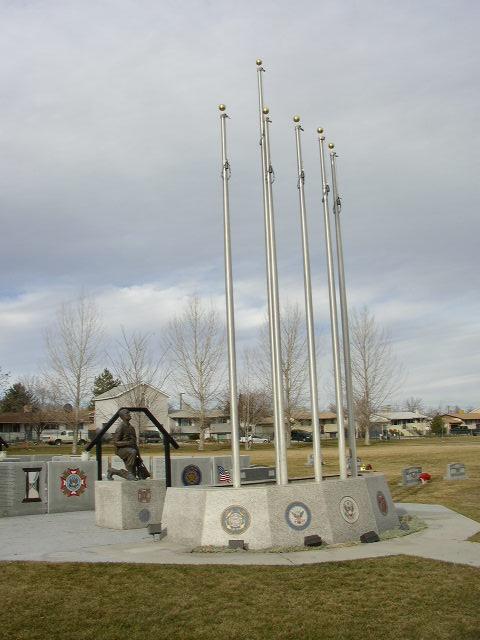Volume 2
Hancock, George Washington, a Pioneer and leading business man of Payson, Utah, was born March 8, 1826, in Columbus, Ohio, the son of Solomon Hancock and Alta Adams. He was baptized in 1834 by Levi W. Hancock, was baptized in Clay county, Missouri, after being driven from Jackson county. Later he moved with his father's family to Far West and later (1839) to Commerce, Hancock county, Illinois, whence he came west in April, 1846. Having arrived on the Missouri river, he enlisted in the Mormon Battalion in July, 1846, and marched all the way to California. After being discharged in 1847, he came to G. S. L. Valley, arriving there in October, 1847. Continuing the journey thence eastward, he reached Council Bluffs about New Year, 1848. Two years later he returned to the Valley and settled at Bountiful, Davis county. After returning from California, being then 20 years old, he married Betsey Jane Fackrell. Subsequently he assisted in the surveying of a road between California and Utah. In 1856 he was called by Pres. Young to settle at Payson, Utah county, and start a store and other mercantile enterprises. Among other things he started a tannery, a shoe and harness factory, a lumber yard and a butcher shop. He also built a grist mill, and later a creamery and canning establishment. He built the first electric plant in Payson and also helped to build the Opera House in that city. At the time of his demise he was particularly engaged in the coal and lumber business. All throughout his busy life Bro. Hancock endeavored to find employment for the poor, and in his dealings with the people in early Utah days he took their produce of every description in exchange for his goods, thus proving a great benefactor to many who otherwise would have suffered for the natural necessities of life. In his earlier days he was ordained a Seventy and acted as a president of his quorum. Later he was ordained a High Priest. His first wife died in 1851, and a year later he married Amy Hancock. By his two wives he became the father of fourteen children. Bro. Hancock died Nov. 15, 1901.
(there is a bio for Amy Hancock)
Three tanning establishments operated for many years in Payson -- one owned by Tousick and Simons, another by J. S. Page, and the third by John Diem. Most of the leather was manufactured into boots and shoes within the city. George W. Hancock's shoe shop at one time employed twenty men. Among those who worked were William Clayson, Thomas Cloward, Jesse Tye, James Butler, David Mitchell, Cynphinas Marsh, and other. Marsh, Butler, and Clayson in later years had shops of their own. A Mr. Cheverall also did business in this line.
George W. and Charles B. Hancock and J. B. Fairbanks were among the first merchants. Benjamin F. Stewart built the first house for the sale of merchandise in 1859. Other early merchants were a Mr. Batchelor, William Douglass, and Hancock and Page.
Electric lights were turned on in Payson December 24, 1890. The power consisted of one dynamo, said to be the first in the state, owned by Thomas Daniels, Jr., and George Hancock. It was in the gristmill at first, and Thomas Daniels, Jr., and George Hancock operated it.
The fruit industry in Payson developed from humble beginnings: George W. Hancock brought a sack of peach stones from Nauvoo in 1856 and planted a part of them for three years in succession before the young trees survived the winters. Charles B. Hancock and David Fairbanks were also early growers of Peaches. Breede Searle sowed the seed of the apple, and his son, J. C. Searle, planted the pit of the Pottawattamie plum. Mrs. Sarah Clifford Finlayson planted the first raspberry plants. This branch of horticulture was discouraging at first, as the plants winterkilled, but in time perseverance brought good results. Charles Wightman brought in the first currant bushes, known as native or wild currants. They may be found now along the field fences. Charles Gale, A. S. Highan and Edmund Harper shipped the first carload of fruit out of Payson. Noted in 1947 for the quality and quality of fruit exported.
Born in Columbia, Ohio, George was a member of the Mormon Battalion.
Source:
Memories That Live Utah County Centennial History, compiled by Emma N. Huff, assisted by Nettie Brown, Edith B. Jones, Emma C. Beardall, published by Daughters of Utah Pioneers of Utah County 1947, printed by Art City Publishing Co., Springville, Utah. P. 450. 451, 452.
* Mormon Battalion members
Volume 2
Hancock, George Washington, a Pioneer and leading business man of Payson, Utah, was born March 8, 1826, in Columbus, Ohio, the son of Solomon Hancock and Alta Adams. He was baptized in 1834 by Levi W. Hancock, was baptized in Clay county, Missouri, after being driven from Jackson county. Later he moved with his father's family to Far West and later (1839) to Commerce, Hancock county, Illinois, whence he came west in April, 1846. Having arrived on the Missouri river, he enlisted in the Mormon Battalion in July, 1846, and marched all the way to California. After being discharged in 1847, he came to G. S. L. Valley, arriving there in October, 1847. Continuing the journey thence eastward, he reached Council Bluffs about New Year, 1848. Two years later he returned to the Valley and settled at Bountiful, Davis county. After returning from California, being then 20 years old, he married Betsey Jane Fackrell. Subsequently he assisted in the surveying of a road between California and Utah. In 1856 he was called by Pres. Young to settle at Payson, Utah county, and start a store and other mercantile enterprises. Among other things he started a tannery, a shoe and harness factory, a lumber yard and a butcher shop. He also built a grist mill, and later a creamery and canning establishment. He built the first electric plant in Payson and also helped to build the Opera House in that city. At the time of his demise he was particularly engaged in the coal and lumber business. All throughout his busy life Bro. Hancock endeavored to find employment for the poor, and in his dealings with the people in early Utah days he took their produce of every description in exchange for his goods, thus proving a great benefactor to many who otherwise would have suffered for the natural necessities of life. In his earlier days he was ordained a Seventy and acted as a president of his quorum. Later he was ordained a High Priest. His first wife died in 1851, and a year later he married Amy Hancock. By his two wives he became the father of fourteen children. Bro. Hancock died Nov. 15, 1901.
(there is a bio for Amy Hancock)
Three tanning establishments operated for many years in Payson -- one owned by Tousick and Simons, another by J. S. Page, and the third by John Diem. Most of the leather was manufactured into boots and shoes within the city. George W. Hancock's shoe shop at one time employed twenty men. Among those who worked were William Clayson, Thomas Cloward, Jesse Tye, James Butler, David Mitchell, Cynphinas Marsh, and other. Marsh, Butler, and Clayson in later years had shops of their own. A Mr. Cheverall also did business in this line.
George W. and Charles B. Hancock and J. B. Fairbanks were among the first merchants. Benjamin F. Stewart built the first house for the sale of merchandise in 1859. Other early merchants were a Mr. Batchelor, William Douglass, and Hancock and Page.
Electric lights were turned on in Payson December 24, 1890. The power consisted of one dynamo, said to be the first in the state, owned by Thomas Daniels, Jr., and George Hancock. It was in the gristmill at first, and Thomas Daniels, Jr., and George Hancock operated it.
The fruit industry in Payson developed from humble beginnings: George W. Hancock brought a sack of peach stones from Nauvoo in 1856 and planted a part of them for three years in succession before the young trees survived the winters. Charles B. Hancock and David Fairbanks were also early growers of Peaches. Breede Searle sowed the seed of the apple, and his son, J. C. Searle, planted the pit of the Pottawattamie plum. Mrs. Sarah Clifford Finlayson planted the first raspberry plants. This branch of horticulture was discouraging at first, as the plants winterkilled, but in time perseverance brought good results. Charles Wightman brought in the first currant bushes, known as native or wild currants. They may be found now along the field fences. Charles Gale, A. S. Highan and Edmund Harper shipped the first carload of fruit out of Payson. Noted in 1947 for the quality and quality of fruit exported.
Born in Columbia, Ohio, George was a member of the Mormon Battalion.
Source:
Memories That Live Utah County Centennial History, compiled by Emma N. Huff, assisted by Nettie Brown, Edith B. Jones, Emma C. Beardall, published by Daughters of Utah Pioneers of Utah County 1947, printed by Art City Publishing Co., Springville, Utah. P. 450. 451, 452.
* Mormon Battalion members
Family Members
Sponsored by Ancestry
Advertisement
Explore more
Sponsored by Ancestry
Advertisement



















